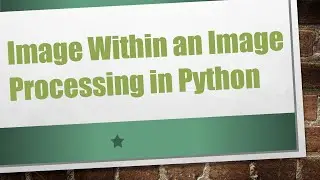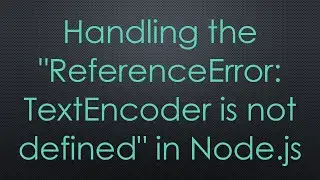How to Change Array Values Inside Objects in JavaScript Without Mutation
Learn how to modify array values inside objects in JavaScript without mutating the original array. This guide offers clear steps and examples to prevent data mutation and achieve clean coding practices.
---
This video is based on the question https://stackoverflow.com/q/65634675/ asked by the user 'foxDev' ( https://stackoverflow.com/u/14884939/ ) and on the answer https://stackoverflow.com/a/65634790/ provided by the user 'Md Sabbir Alam' ( https://stackoverflow.com/u/2913723/ ) at 'Stack Overflow' website. Thanks to these great users and Stackexchange community for their contributions.
Visit these links for original content and any more details, such as alternate solutions, latest updates/developments on topic, comments, revision history etc. For example, the original title of the Question was: How can I change array value(inside array of objects) without mutating the container? javascript
Also, Content (except music) licensed under CC BY-SA https://meta.stackexchange.com/help/l...
The original Question post is licensed under the 'CC BY-SA 4.0' ( https://creativecommons.org/licenses/... ) license, and the original Answer post is licensed under the 'CC BY-SA 4.0' ( https://creativecommons.org/licenses/... ) license.
If anything seems off to you, please feel free to write me at vlogize [AT] gmail [DOT] com.
---
How to Change Array Values Inside Objects in JavaScript Without Mutation
When working with JavaScript, manipulating objects and arrays can sometimes lead to unintended side effects, especially when it comes to mutating the original data. If you've found yourself needing to change the values in an array of objects without altering the original containers, you're not alone. This guide will guide you through the process of filling an array based on certain conditions, all while ensuring that the original data remains intact—this is often referred to as a "non-mutative" approach.
The Problem
In our scenario, we have an array of objects named present, where each object includes a name and a corresponding empty presents array. Our goal is to add values to the presents array for a specific individual, in this case, "Mario," based on the contents of another array, arr, without changing the state of the present array itself.
Initial Data Setup
Let’s look at our initial code snippet:
[[See Video to Reveal this Text or Code Snippet]]
After attempting to modify it, we found that our original attempt resulted in modifying present, which we want to avoid.
The Solution
To achieve our goal without mutating the original present array, we can utilize the reduce() method. This method allows us to iterate through each object while creating a new array that reflects our desired changes.
Step-by-Step Breakdown
Use reduce(): Utilize the reduce() function to iterate through the present array while constructing a new result array.
Conditionally Modify Objects: Within the callback function, add a condition to check if the current object's name is "Mario." If it is, create a new object that includes the updated presents array. If not, push the current object as is into the result array.
Return the Result: After processing all items, return the newly created array.
Here's how the complete code looks:
[[See Video to Reveal this Text or Code Snippet]]
Explanation of the Code
Spread Operator (...): This operator allows us to create a new object that includes the properties of the current object while also updating the presents array without altering the original present array.
Array Creation: The res will now contain the updated objects, with Mario's presents filled with ["car", "coal"], without changing the original present data structure.
Conclusion
Utilizing the reduce() method in JavaScript is an effective way to modify arrays inside objects while adhering to a non-mutative approach. This ensures the integrity of your original data and promotes clean and predictable code. By applying these techniques in your projects, you can manage data immutably and avoid common pitfalls associated with mutation in JavaScript.
Happy Coding!































